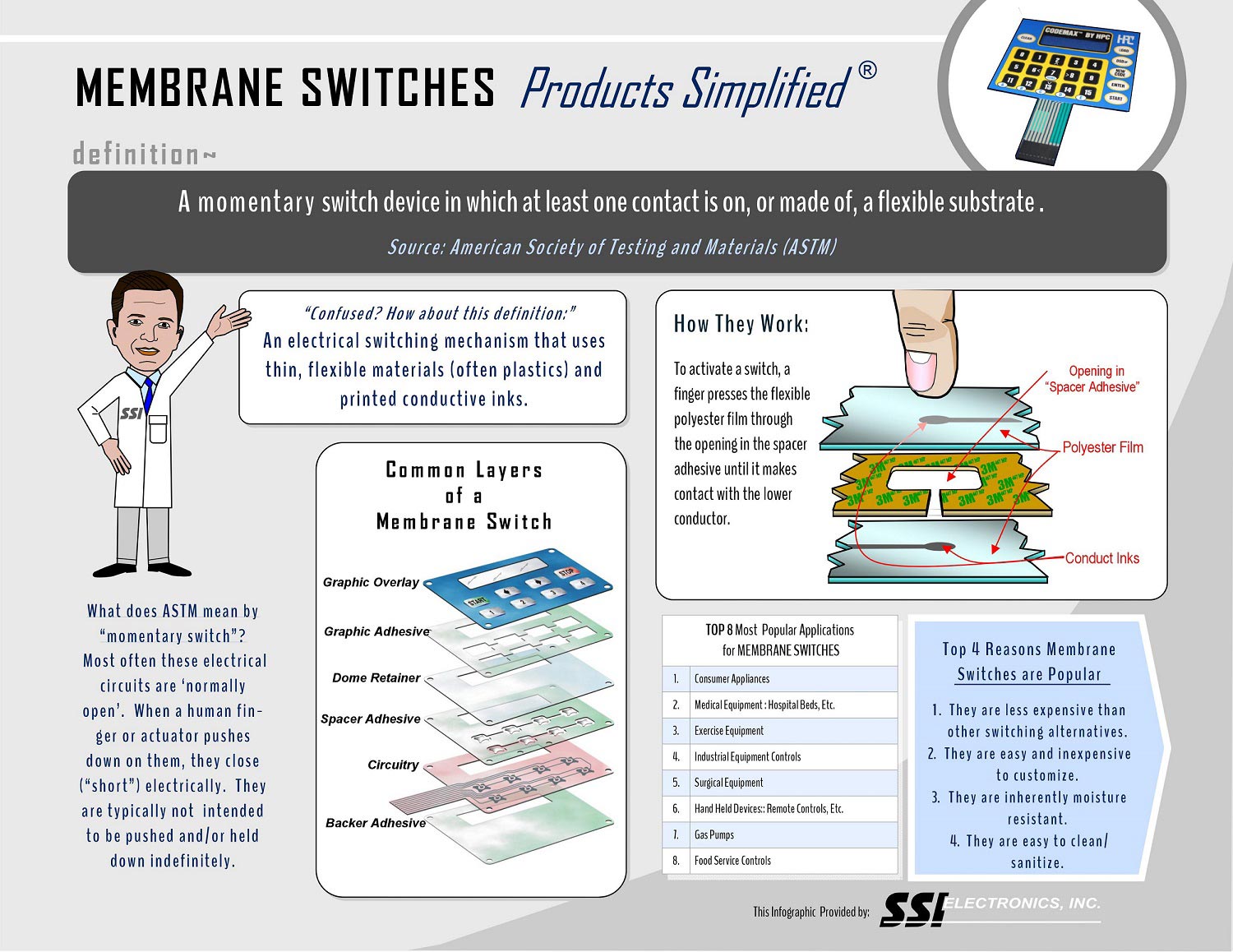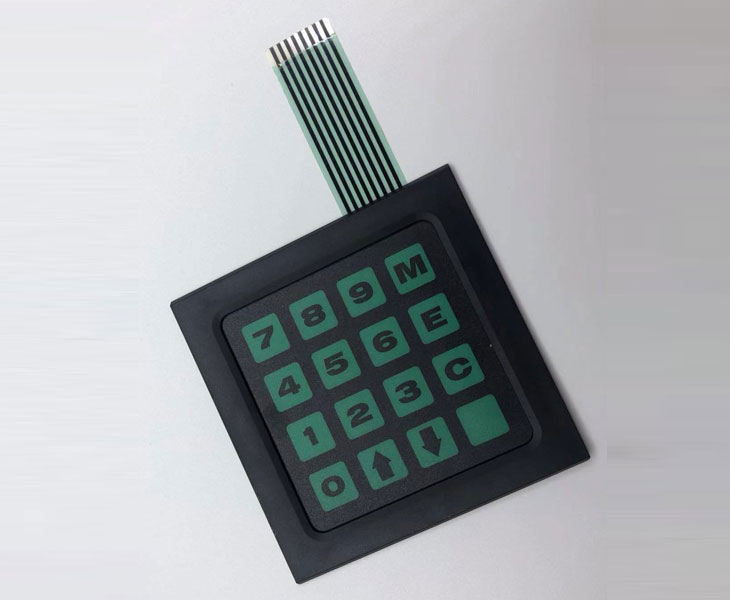Everything About Membrane layer Switch: A Comprehensive Overview for Beginners
Membrane layer buttons are important elements in modern-day electronic devices, providing an unique interface for user communication - membrane switch. Their layered building, including overlays and conductive traces, provides capability and longevity. Unlike conventional mechanical switches, membrane layer switches provide a streamlined layout and customizable alternatives. Understanding their vital functions and advantages can transform product design. The intricacies of their application and style factors to consider warrant additional expedition.
What Is a Membrane Switch?
A membrane switch is a kind of electric switch that contains a flexible membrane layer layered over a published motherboard. This layout enables a sleek and small interface, often utilized in various electronic gadgets. Membrane buttons are generally located in consumer home appliances, medical devices, and industrial machinery because of their sturdiness and resistance to environmental factors.The building normally consists of several layers, such as visuals overlays and glue support, which supply tactile comments and secure the circuitry underneath. The operation of a membrane button is launched when pressure is related to the surface, finishing an electric circuit.These buttons are valued for their convenience, making it possible for custom-made layouts and published graphics that accommodate certain interface. Their low-profile nature reduces space needs, making them excellent for applications where standard switches might not fit. On the whole, membrane buttons use a practical and aesthetic solution for contemporary electronic tools.
Secret Elements of Membrane Switches
Membrane layer changes comprise numerous vital parts that add to their functionality and efficiency. The leading layer, called the overlay, provides the individual interface and is frequently printed with signs or graphics. Beneath the overlay exists a spacer layer, which separates the conductive elements and stops inadvertent activation. The next crucial component is the visuals layer, which enhances aesthetics and ensures the durability of the design.Conductive traces, normally made from materials like silver or carbon, are printed on the circuit layer. When pressure is related to the overlay, these traces enter into contact, completing the circuit. In addition, a backing layer provides structural assistance and can be made from products such as polyester or polycarbonate. With each other, these components develop a reliable, straightforward interface ideal for numerous applications, from house devices to commercial equipment. Comprehending these aspects is essential for any individual curious about membrane layer button innovation.
Just How Membrane Layer Switches Work
Comprehending just how membrane layer switches over feature is important for appreciating their widespread use in various gadgets. A membrane layer switch operates through a series of layers, including a graphic overlay, spacer, and a circuit layer. When pressure is related to the overlay, it presses the spacer layer, permitting the circuit layer to make call and finish an electrical circuit. This action sends a signal to the device, prompting an action, such as transforming on a light or turning on a function.Membrane switches over can be developed with numerous attributes, consisting of tactile feedback, backlighting, and custom graphics, boosting customer communication. Their construction permits a covered style, shielding the internal parts from dust, moisture, and pollutants. This longevity makes them appropriate for diverse applications, from customer electronic devices to commercial devices. Overall, the simpleness and performance of membrane layer changes contribute to their appeal in modern innovation.
Advantages of Membrane Layer Switches Over Over Mechanical Buttons
While mechanical buttons have long been a staple in numerous devices, membrane layer switches deal distinctive benefits that make them increasingly appealing. One substantial benefit is their slim account, permitting even more compact styles and higher flexibility in item development. Furthermore, membrane layer switches function a consistent surface area, which enhances aesthetic charm and streamlines cleansing, making them suitable for settings where health is critical.Another benefit is their resistance to dirt and moisture. Unlike mechanical switches, which can be jeopardized by ecological factors, membrane buttons give a covered interface that secures versus impurities - membrane switch. Membrane switches commonly have a longer lifespan due to fewer moving components, resulting in enhanced resilience and reliability.Cost-effectiveness is likewise a significant benefit, as membrane layer switches can be produced in bulk with reduced manufacturing costs. These elements combine to position membrane layer switches as a functional option to traditional mechanical choices in various applications
Common Applications of Membrane Changes
Membrane layer switches are widely used in numerous fields, specifically in customer electronics and industrial control panels. In consumer tools, they give a smooth, easy to use interface, while in commercial setups, they enhance sturdiness and functionality. Understanding these applications highlights the convenience and functionality of membrane buttons in contemporary technology.
Consumer Electronics Tools
As consumer electronic devices remain to advance, membrane layer switches have actually come to be a preferred choice for a range of devices as a result of their adaptability and sleek style. These buttons are typically located in mobile phones, tablet computers, and push-button controls, where space is minimal and appearances matter. Their low account and adjustable layouts allow manufacturers to produce straightforward user interfaces that improve the overall individual experience. In addition, membrane switches are frequently made use of in appliances such as microwaves and coffee machine, giving intuitive control alternatives while resisting dampness and dust. The resilience and dependability of membrane layer switches make them appropriate for day-to-day customer items, ensuring durability and regular efficiency. Overall, their integration in customer electronics mirrors a mix of performance and modern-day design.
Industrial Control Panels
The applications of membrane layer changes prolong past customer electronic devices, locating significant use in commercial control panels. These switches are favored for their toughness and resistance to rough settings, making them optimal for making and procedure control setups. They supply a trustworthy user interface for drivers to manage machinery, display procedures, and readjust setups. Membrane switches can be personalized to suit particular operational needs, integrating functions like backlighting and tactile feedback, improving customer experience. Their low-profile design allows for combination into various tools, while their capability to withstand spills, dust, and extreme temperature levels assurances durability. In general, membrane buttons add to risk-free and effective operation in industrial applications, showing their versatility and performance sought after environments.
Factors To Consider for Creating Membrane Switches Over
When developing membrane layer switches, choosing the best products is important to assure sturdiness and functionality. In addition, understanding layer setup methods can substantially influence the switch's performance and user experience. These considerations play an essential duty in creating reputable and efficient membrane layer switch layouts.
Material Choice Relevance
Product choice plays a vital function in the design and functionality of membrane layer buttons. The picked products straight affect the switch's sturdiness, responsive action, and total aesthetic. Key considerations consist of the substratum, which must give structural stability while enabling flexibility, and the graphic overlay, which requires to be immune to wear and ecological aspects. Conductive materials need to assure trusted electrical efficiency, while adhesives need to provide strong bonding without compromising the switch's procedure. Additionally, compatibility with manufacturing processes and end-user atmospheres is important; products have to endure differing temperature levels, humidity levels, and chemical direct exposure. Inevitably, suitable product option not just boosts the membrane layer button's performance yet also useful reference contributes to its durability and customer satisfaction, making it a vital element of the style procedure.

Layer Setup Methods

Frequently Asked Concerns
Exactly How Lengthy Do Membrane Changes Typically Last?
Membrane switches normally have a lifespan of 1 to 5 million cycles, relying on use and environmental conditions. Elements such as style high quality and operating regularity greatly influence their sturdiness and overall performance longevity.

Can Membrane Layer Changes Be Personalized for Particular Styles?
Membrane layer buttons can indeed be tailored to accommodate certain styles, permitting for diverse shapes, shades, and capabilities. This versatility allows manufacturers to tailor these buttons to meet unique visual and operational requirements effectively.
What Products Are Made Use Of in Membrane Layer Switch Building?
Membrane switches are generally created using materials such as polyester, polycarbonate, and glue layers. These materials give resistance, resilience, and versatility to ecological factors, ensuring the buttons operate successfully in various applications and problems.
Are Membrane Changes Waterproof or Immune to Wetness?
Membrane layer switches can be created to be moisture-resistant, using specialized finishes and materials. Their waterproof capabilities depend on building and construction high quality and certain applications, making it crucial to evaluate demands for optimal efficiency in numerous settings.
How Are Membrane Changes Fixed if Harmed?
Repairing broken membrane switches typically includes changing the impacted layer or circuit. check this site out Technicians might likewise apply conductive sticky or make use of specialized repair work packages, guaranteeing performance is recovered without full replacement of the whole button setting up. Unlike standard mechanical buttons, membrane switches offer a smooth style and personalized choices. A membrane button is a kind of electrical switch that consists of a versatile membrane layered over a printed circuit board. The operation of a membrane layer switch is started when stress is applied to the surface area, completing an electrical circuit.These switches are valued for their flexibility, making it possible for customized styles and published graphics that cater to details individual interfaces. While mechanical switches have actually long been a staple in lots of gadgets, membrane switches deal unique advantages that make them progressively appealing. Membrane buttons generally have a longer lifespan due to less moving components, resulting in improved resilience and reliability.Cost-effectiveness is additionally a notable advantage, as membrane layer buttons can be produced in mass with lower production costs.
Comments on “Membrane switch in gadget design: user experience considerations”